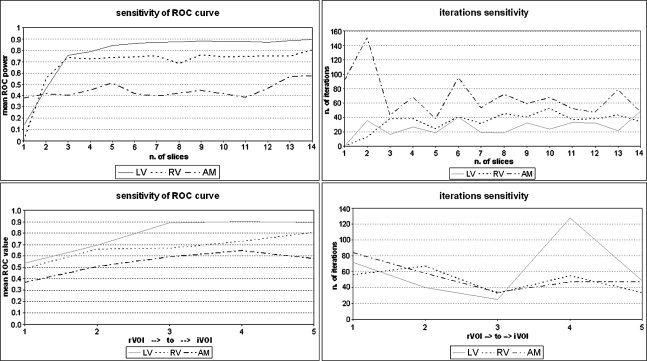Figure 4.

The left panels present the mean measure of the ROC curve as a function of the selected increasing VOI (from slice 1 to 14 for the slice‐based approach in the upper panel and five functional‐based VOIs in the lower panel), for the three main functional activities (auditory‐motor [AM], left visual [LV], and right visual [RV]). The curves were obtained from the whole ROC curve using only 0–0.1 false positive ratio regions as used in this article. We used three different imaging sessions and the results are reported for the three sessions averaged out. The measures of spatial accuracy revealed that the iVOI approach can ensure superior performances in terms of ROC power than the rVOI one can: by increasing the number of voxels, the extracted independent components perform better to multiple regression analysis benchmarks. We noticed that for the Cauditory‐motor, j in the slice‐based approach, including additional spatial volumes with new sources causes a transitory slow down in the mean ROC value, which rises again by including further extra spatial volumes, useful for the auditory‐motor component. Specifically, this fall occurs when including the extra auditory area (slice 7) until when including the motor area (slice 11). The graphs on the right represent the mean number of iterations necessary for extracting the representative independent components as function of the selected increasing VOI for the three main functional activities (AM, LV, RV). The number of iterations for extracting the best ROC power task‐related extracted components in the iVOI approach is on the average lower than that in the rVOI approach. Furthermore, in the slice‐based approach, including additional spatial volumes with new sources causes a transitory rise in the number of iterations, which goes again down by including further extra spatial volumes, useful for the auditory‐motor component Cauditory‐motor, j. The number of iterations seems to be affected by the structure of the sample used in spatial ICA in a way that the more information about the sources affecting the data, the faster (and more accurate) the estimation is.
